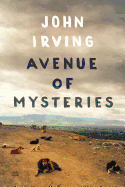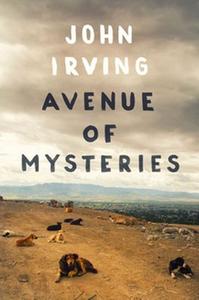
 When John Irving became a finalist for the 1978 National Book Award with The World According to Garp, he leaped from mid-list, MFA-schooled, literary fiction obscurity to international fame and enough fortune thereafter to write pretty much whatever he wanted. In the almost four decades since, he has published 10 novels (including The Cider House Rules and The Fourth Hand) and has had several works adapted to film. Often long and heavily plotted, Irving's fiction regularly features troubled childhoods, violent maiming, sexual promiscuity, circuses, sports, religion, writers and writing, domesticated animals, travel and memory. Avenue of Mysteries sits right in the sweet spot of Irving's obsessions--and as with his past books, its imaginative storytelling overcomes its plot complexity and characters' often over-the-top behavior.
When John Irving became a finalist for the 1978 National Book Award with The World According to Garp, he leaped from mid-list, MFA-schooled, literary fiction obscurity to international fame and enough fortune thereafter to write pretty much whatever he wanted. In the almost four decades since, he has published 10 novels (including The Cider House Rules and The Fourth Hand) and has had several works adapted to film. Often long and heavily plotted, Irving's fiction regularly features troubled childhoods, violent maiming, sexual promiscuity, circuses, sports, religion, writers and writing, domesticated animals, travel and memory. Avenue of Mysteries sits right in the sweet spot of Irving's obsessions--and as with his past books, its imaginative storytelling overcomes its plot complexity and characters' often over-the-top behavior.
Avenue of Mysteries is a rambling story that moves in and out of chronological time as it travels across time zones. At 14 years old, Juan Diego lives in a shack with his younger sister, Lupe, and their suspected father, Rivera, outside Oaxaca, Mexico. They are the "dump kids," and Rivera the "dump jefe." By the time he is 54, the novelist-protagonist Juan Diego (if a novel with many, many characters can have only one protagonist) is visiting Our Lady of Guadalupe Church in Manila, Philippines, ruminating on the many ghosts and memories from his past.
He is known as the "dump reader" because of his self-taught ability to read dense religious and classic fiction texts in both English and Spanish. Lupe is born with the clairvoyance to read people's thoughts and occasionally predict the future, which she expresses in a language that only Juan Diego can understand. Along the journey of Juan Diego's life, he and Lupe join a traveling Oaxacan circus, and Rivera accidently runs over Juan Diego's foot, giving him a permanent limp. Intellectually confused, Juan Diego makes a pilgrimage to the Mexico City Virgen de Guadalupe (along the city's Avenida de los Misterios) to sort out his conflicting allegiances to the Virgin Mary and Aztec goddess Coatlicue, after which he is adopted by the transgender Oaxacan prostitute Flor and Iowan missionary priest Eduardo, who forsakes his vows for Flor. They take him to Iowa City, where he studies and then teaches writing at the University of Iowa. Falling in with a sexually obsessed, well-traveled mother and daughter on a flight to Manila, he visits the gravesite of American soldiers and worries about mixing up the dosages of his beta-blocker and Viagra pills. (Whew!)
Juan Diego is an inspired character who provides Irving with a platform from which to explore the mysteries of growing old, of religious fanaticism and fantasy, of language, of companionship and love, and especially of writing. Regarding his maimed foot, Juan Diego thinks: "A cripple's life is one of watching others do what he can't do, not the worst option for a future novelist." From wherever it came, Irving's knack for telling a good story is as strong as ever. --Bruce Jacobs, founding partner, Watermark Books & Cafe, Wichita, Kan.
Shelf Talker: The prolific John Irving tells of a broken-footed writer's journey from his youth in Oaxaca, Mexico, through a professorship in Iowa City to a middle-aged visit to Manila, Philippines.

